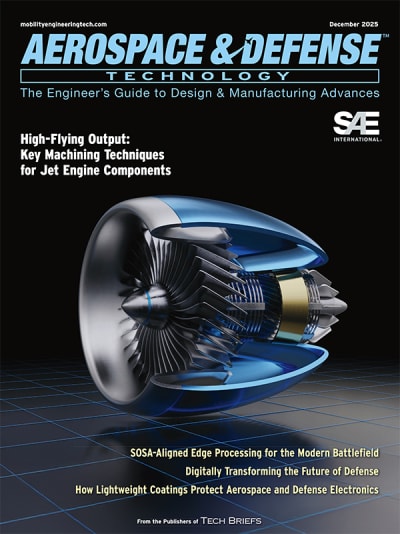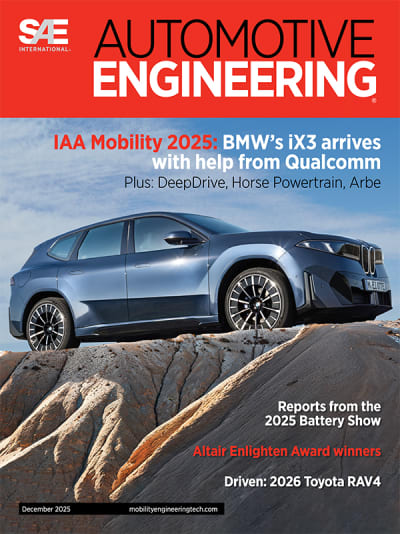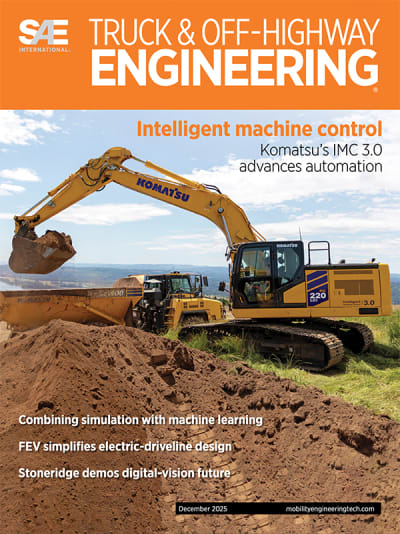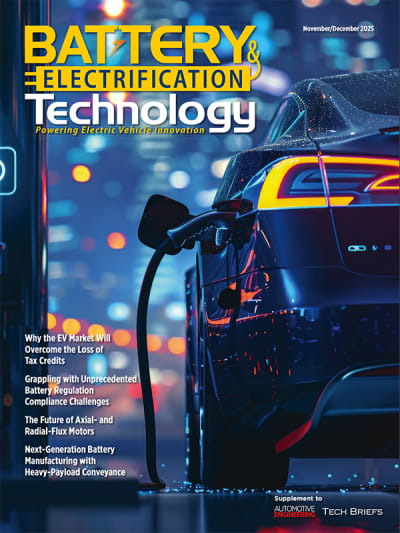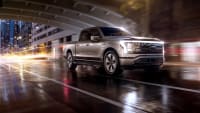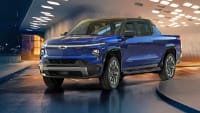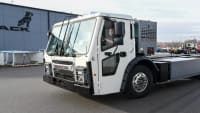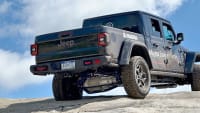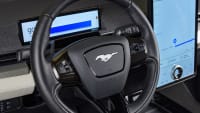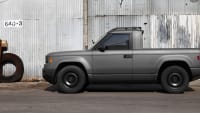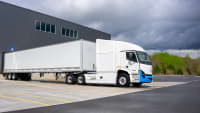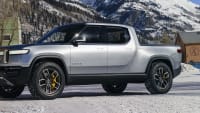2022 Ford F-150 Lightning Redefines the Pickup Paradigm
The nation’s perennial best-selling nameplate goes electric – and becomes more compelling

Just before the media test drives of the 2022 F-150 Lightning, the battery-electric variant of Ford’s market-dominating light-duty pickup truck, the Lightning’s specs were updated to reflect modest last-minute enhancements in horsepower and payload capacity. The freshly-extracted extra horsepower and payload are useful, but hardly necessary: the F-150 Lightning would’ve been plenty spectacular regardless. If the F-150 Lightning is the standard we can expect from “electrifying” what we’re already familiar with, nobody will need to be dragged, kicking and screaming, into the EV future.

Ford planners and engineers took the bull by the horns when it was decided the EV variant of a pickup that’s sold some 40 million copies had to fulfill the same product brief – that is, offer essentially the same work-ready capabilities as every F-Series that’s come before. Not only does the F-150 Lightning accomplish that, adding either the 98-kWh (standard range), SK Innovation-made lithium-ion battery or the 131-kWh extended-range battery offers all manner of new capabilities linked to having so much electricity onboard.
Battery-defined capabilities


The choice of battery packs is important in two chief ways and effectively defines the F-150 Lightning for users. The standard range battery powers a maximum driving range of 230 miles (370 km) and means the twin traction motors – one at each axle for full-time all-wheel-drive (AWD) – deliver a combined 452 hp and 775 lb-ft (1051 Nm). The extended-range battery’s 131 kWh hikes maximum range to 320 miles (515 km) and allows 580 hp to be extracted from the twin drive motors; torque output for either battery pack is the same. The battery pack is situated between the rails of the Lightning-specific high-strength steel frame and is protected by a steel skid plate in the event the Lightning’s 8.4 inches (213 mm) of ground clearance isn’t sufficient (conventional F-150 4X4: 9.4 inches). Ford engineers said just eight easily accessible mounting points allow the entire battery pack to be removed.
The standard-range battery, then, appears adequate for those users who, like many light-truck owners, don’t have rigorous hauling or towing demands – or, in the case of the fleet operations targeted by the base-model Pro trim, might have specifically defined duty cycles and routes that reliably return to a central charging location. Not to say the standard-range battery precludes genuine work duty: its maximum tow rating is a chunky 7700 lb (3493 kg) and the extended-range battery enables towing up to 10,000 lb (4536 kg). Either battery pack facilitates a max payload rating of 2235 lb (1014 kg) – the late-arriving increase mentioned earlier over the 2000-lb (907-kg) payload capacity Ford originally listed. Engineers at the media drive program in May said 75% of current F-150 customers tow, but fully 80% of that number do not tow more than 10,000 lb.


Towing and hauling capability are the “real-truck” metrics, however, and Ford gamely set up journalists with plenty of options to test the Lightning in order to dispel what some engineers called “myths” about towing’s derogatory effect on driving range. With trailers ranging up to 9500 lb (4309 kg), the Lightning yanked them as easily as you’d pull a toddler across the snow on a plastic toboggan. And without any driveline “windup” or fuss, no blaring exhaust (a downside for the coal-rolling crowd, I suppose), just the crisp and smart step-off of 775 lb-ft applied instantly and silently.
The Texas hill-country test roads were rolling but fairly low-speed. The handy functionality of the Lightning’s Intelligent Range feature (program your trailer’s weight and other environmental effects are calculated), generated a forecast, backed up by on-the-fly mile-per-kWh figures that indicated the extended battery pack’s 320-mile range might be cut in half by a heavy trailer. The impact is “very similar to what you get on the F-150 gas,” said Jim Caruso, vehicle engineering supervisor.
High-speed highway towing probably would consume more. But unless you’ve got an IC pickup with large or even twin fuel tanks, more than 160 miles before refueling can be a stretch – although the refueling time is a fraction of the 41 minutes required to take the extended battery from 15% to 80% capacity at a DC fast-charger, according to Ford. A 15% to 100% recharge with a 48-amp Level 2 setup at the high end of what consumers are likely to have installed at home is a 13-hour commitment, although if one is of the means to plump for the 80-amp Charge Station Pro, that Level 2 recharge is cut to eight hours.
It’s doubtful those maxing out the payload or towing light-ish trailers would find a too-painful effect on driving range – but those who plan on routine towing of heavier loads had best figure on the extended-range battery. With either battery, the 2022 F-150 Lightning isn’t the ultimate work configuration – the payload and tow ratings place the Lightning about in the middle of the conventional F-150’s capability range – but it’s more than able to serve most light-duty pickup use cases. For the rest, electric in its current state of development simply isn’t the answer.
New-age dynamics
We spent the better part of a day road-driving the F-150 Lightning Pro fitted with the extended-range battery, the Tow Technology and Max Trailer Tow packages and a few other options that took it from a base price of $39,974 to $56,109 (which included the $1,695 destination charge), a configuration that appealed as a heap of electric truck for the money. The Ford-developed, 3-phase AC induction motors replicate the imperceptible AWD traction expected of a family crossover, while the standard electronically locking rear differential and the truck’s also-standard off-road drive setting equip the Lightning to scrabble up challenging loose-rock hill climbs and traverse slimy-mud water crossings.
Curb weights for EVs are a current flashpoint and Ford was cagey about the Lightning’s poundage, electing not to provide a listing in the truck’s specifications. Various sources said on-site that weights range from about 6200-7000 lb (2812-3175 kg). Pickup weights vary widely, so we’ll just say roughly 1000 lb (454 kg) heavier than an equivalent IC-powered F-150. The weight and its low positioning – not to mention the Lightning’s independent rear suspension – help impart a confident effect on cornering, while, fortuitously, the gutting of the engine up front, said engineers, leaves the truck with a nearly 50/50 front/rear weight distribution. The F-150 Lightning rolls sweetly and crushingly silently down the road and accelerates hard enough to scandalize just about any common IC vehicle. So-called “one-pedal” driving is a delight; using it, owners might not need brakes for years (Ford in fact projects scheduled-maintenance costs some 40% lower than a conventional F-150 over five years or 75,000 miles). The only dynamic foible we could discern was the damping seems overworked to control rebound when humps, bumps and dips were encountered at highway speeds.
Familiarity mixed with new features
Mercifully, the F-150 Lightning lineup is pared-back by pickup standards. There are just four trim levels: Pro, XLT, Lariat and Platinum. And compare Lightning’s “single-spec” – a drivetrain setup of a battery pack, two motors and AWD available in a crew-cab body – with the five engine variants, separate transmission, 2WD/4WD, seven trim levels and three cab-configuration matrix currently available for the IC-propelled F-150 lineup and one can see why electrification can liberate (force?) product-complexity benefits.
There’s a certain features reset provided by the Lightning’s nifty new functions, such as Pro Power Onboard (9.6 kW of mobile power for anything you want to plug in, including 240V power hogs), the 14.1 cu-ft “frunk” storage (“the hardest thing we did, insisted Darren Palmer, VP, electric-vehicle programs) and myriad software enablers, but maybe the triumph of the Lightning is that there’s nothing “EV recherche” – most of the Lightning’s body and interior are straight off the IC pickup’s line. There’s still the big ‘ol T-handle shifter, after all. Those other than F-Series watchers or EV enthusiasts will have a hard time identifying the Lightning isn’t one of its fossil-fuel counterparts.
For Ford and its perennially best-selling F-Series, departing from what’s familiar probably wasn’t ever an option. And for now, it doesn’t need to be – the 2022 F-150 Lightning’s “real-truck” credentials are plenty sufficient, while the clever and convincing integration of electric propulsion and all its feature-facilitating trimmings make it a thoroughly convincing EV in its own right. The F-150’s gargantuan size won’t be for everyone – particularly ardent EV enthusiasts – and gilded versions on the press preview topped $95,000. But given the sparkling reception the F-150 Lightning already is enjoying, Ford need merely transfer its winning engineering to more-manageable and less-costly footprints and there’s probably no looking back.
Top Stories
INSIDERRF & Microwave Electronics
![]() FAA to Replace Aging Network of Ground-Based Radars
FAA to Replace Aging Network of Ground-Based Radars
PodcastsDefense
![]() A New Additive Manufacturing Accelerator for the U.S. Navy in Guam
A New Additive Manufacturing Accelerator for the U.S. Navy in Guam
NewsSoftware
![]() Rewriting the Engineer’s Playbook: What OEMs Must Do to Spin the AI Flywheel
Rewriting the Engineer’s Playbook: What OEMs Must Do to Spin the AI Flywheel
Road ReadyPower
![]() 2026 Toyota RAV4 Review: All Hybrid, All the Time
2026 Toyota RAV4 Review: All Hybrid, All the Time
INSIDERDefense
![]() F-22 Pilot Controls Drone With Tablet
F-22 Pilot Controls Drone With Tablet
INSIDERRF & Microwave Electronics
![]() L3Harris Starts Low Rate Production Of New F-16 Viper Shield
L3Harris Starts Low Rate Production Of New F-16 Viper Shield
Webcasts
Energy
![]() Hydrogen Engines Are Heating Up for Heavy Duty
Hydrogen Engines Are Heating Up for Heavy Duty
Energy
![]() SAE Automotive Podcast: Solid-State Batteries
SAE Automotive Podcast: Solid-State Batteries
Power
![]() SAE Automotive Engineering Podcast: Additive Manufacturing
SAE Automotive Engineering Podcast: Additive Manufacturing
Aerospace
![]() A New Approach to Manufacturing Machine Connectivity for the Air Force
A New Approach to Manufacturing Machine Connectivity for the Air Force
Software
![]() Optimizing Production Processes with the Virtual Twin
Optimizing Production Processes with the Virtual Twin

